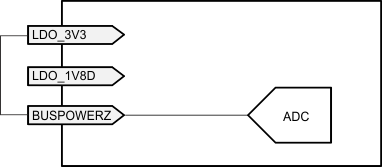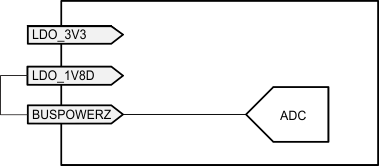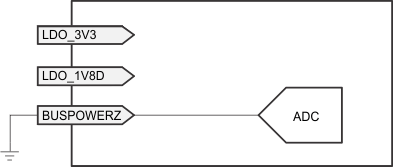SLVSDC2C February 2016 – August 2021 TPS65981
PRODUCTION DATA
- 1 Features
- 2 Applications
- 3 Description
- 4 Revision History
- 5 Description (continued)
- 6 Pin Configuration and Functions
-
7 Specifications
- 7.1 Absolute Maximum Ratings
- 7.2 ESD Ratings
- 7.3 Recommended Operating Conditions
- 7.4 Thermal Information
- 7.5 Power Supply Requirements and Characteristics
- 7.6 Power Supervisor Characteristics
- 7.7 Power Consumption Characteristics
- 7.8 Cable Detection Characteristics
- 7.9 USB-PD Baseband Signal Requirements and Characteristics
- 7.10 USB-PD TX Driver Voltage Adjustment Parameter
- 7.11 Port Power Switch Characteristics
- 7.12 Port Data Multiplexer Switching Characteristics
- 7.13 Port Data Multiplexer Clamp Characteristics
- 7.14 Port Data Multiplexer SBU Detection Requirements
- 7.15 Port Data Multiplexer Signal Monitoring Pullup and Pulldown Characteristics
- 7.16 Port Data Multiplexer USB Endpoint Requirements and Characteristics
- 7.17 Port Data Multiplexer BC1.2 Detection Requirements and Characteristics
- 7.18 Analog-to-Digital Converter (ADC) Characteristics
- 7.19 Input-Output (I/O) Requirements and Characteristics
- 7.20 I2C Slave Requirements and Characteristics
- 7.21 SPI Controller Characteristics
- 7.22 BUSPOWERZ Configuration Requirements
- 7.23 Single-Wire Debugger (SWD) Timing Requirements
- 7.24 Thermal Shutdown Characteristics
- 7.25 HPD Timing Requirements and Characteristics
- 7.26 Oscillator Requirements and Characteristics
- 7.27 Typical Characteristics
- 8 Parameter Measurement Information
-
9 Detailed Description
- 9.1 Overview
- 9.2 Functional Block Diagram
- 9.3
Feature Description
- 9.3.1 USB-PD Physical Layer
- 9.3.2 Cable Plug and Orientation Detection
- 9.3.3
Port Power Switches
- 9.3.3.1 5-V Power Delivery
- 9.3.3.2 5V Power Switch as a Source
- 9.3.3.3 PP_5V0 Current Sense
- 9.3.3.4 PP_5V0 Current Limit
- 9.3.3.5 Internal HV Power Delivery
- 9.3.3.6 Internal HV Power Switch as a Source
- 9.3.3.7 Internal HV Power Switch as a Sink
- 9.3.3.8 Internal HV Power Switch Current Sense
- 9.3.3.9 Internal HV Power Switch Current Limit
- 9.3.3.10 External HV Power Delivery
- 9.3.3.11 External HV Power Switch as a Source with RSENSE
- 9.3.3.12 External HV Power Switch as a Sink With RSENSE
- 9.3.3.13 External HV Power Switch as a Sink Without RSENSE
- 9.3.3.14 External Current Sense
- 9.3.3.15 External Current Limit
- 9.3.3.16 Soft Start
- 9.3.3.17 BUSPOWERZ
- 9.3.3.18 Voltage Transitions on VBUS through Port Power Switches
- 9.3.3.19 HV Transition to PP_RV0 Pull-down on VBUS
- 9.3.3.20 VBUS Transition to VSAFE0V
- 9.3.3.21 C_CC1 and C_CC2 Power Configuration and Power Delivery
- 9.3.3.22 PP_CABLE to C_CC1 and C_CC2 Switch Architecture
- 9.3.3.23 PP_CABLE to C_CC1 and C_CC2 Current Limit
- 9.3.4
USB Type-C® Port Data Multiplexer
- 9.3.4.1 USB Top and Bottom Ports
- 9.3.4.2 Multiplexer Connection Orientation
- 9.3.4.3 SBU Crossbar Multiplexer
- 9.3.4.4 Signal Monitoring and Pull-up and Pull-down
- 9.3.4.5 Port Multiplexer Clamp
- 9.3.4.6 USB2.0 Low-Speed Endpoint
- 9.3.4.7 Battery Charger (BC1.2) Detection Block
- 9.3.4.8 BC1.2 Data Contact Detect
- 9.3.4.9 BC1.2 Primary and Secondary Detection
- 9.3.5 Power Management
- 9.3.6 Digital Core
- 9.3.7 USB-PD BMC Modem Interface
- 9.3.8 System Glue Logic
- 9.3.9 Power Reset Congrol Module (PRCM)
- 9.3.10 Interrupt Monitor
- 9.3.11 ADC Sense
- 9.3.12 I2C Slave
- 9.3.13 SPI Controller
- 9.3.14 Single-Wire Debugger Interface
- 9.3.15 DisplayPort HPD Timers
- 9.3.16 ADC
- 9.3.17 I/O Buffers
- 9.3.18 Thermal Shutdown
- 9.3.19 Oscillators
- 9.4 Device Functional Modes
- 9.5 Programming
-
10Application and Implementation
- 10.1 Application Information
- 10.2
Typical Applications
- 10.2.1
Fully-Featured USB Type-C® and PD Charger
Application
- 10.2.1.1 Design Requirements
- 10.2.1.2
Detailed Design Procedure
- 10.2.1.2.1 TPS65981 External Flash
- 10.2.1.2.2 Debug Control (DEBUG_CTL) and I2C (I2C) Resistors
- 10.2.1.2.3 Oscillator (R_OSC) Resistor
- 10.2.1.2.4 VBUS Capacitor and Ferrite Bead
- 10.2.1.2.5 Soft Start (SS) Capacitor
- 10.2.1.2.6 USB Top (C_USB_T), USB Bottom (C_USB_B), and Sideband-Use (SBU) Connections
- 10.2.1.2.7 Port Power Switch (PP_EXT, PP_HV, PP_5V0, and PP_CABLE) Capacitors
- 10.2.1.2.8 Cable Connection (CCn) Capacitors and RPD_Gn Connections
- 10.2.1.2.9 LDO_3V3, LDO_1V8A, LDO_1V8D, LDO_BMC, VIN_3V3, and VDDIO
- 10.2.1.3 Application Curve
- 10.2.2
USB Type-C® and PD Dock or Monitor
Application
- 10.2.2.1 Design Requirements
- 10.2.2.2
Detailed Design Procedure
- 10.2.2.2.1 Port Power Switch (PP_5V0 and PP_CABLE) Capacitors
- 10.2.2.2.2 HD3SS460 Control and DisplayPort Configuration
- 10.2.2.2.3 AC-DC Power Supply (Barrel Jack) Detection Circuitry
- 10.2.2.2.4 TPS65981 Control of Variable Buck Regulator Output Voltage (PP_HV)
- 10.2.2.2.5 TPS65981 and System Controller Interaction
- 10.2.2.3 Application Curves
- 10.2.1
Fully-Featured USB Type-C® and PD Charger
Application
- 11Power Supply Recommendations
-
12Layout
- 12.1
Layout Guidelines
- 12.1.1 TPS65981 Recommended Footprint
- 12.1.2 Top TPS65981 Placement and Bottom Component Placement and Layout
- 12.1.3 Component Placement
- 12.1.4 Designs Rules and Guidance
- 12.1.5 Routing PP_HV, PP_EXT, PP_5V0, and VBUS
- 12.1.6 Routing Top and Bottom Passive Components
- 12.1.7 Thermal Pad Via Placement
- 12.1.8 Top Layer Routing
- 12.1.9 Inner Signal Layer Routing
- 12.1.10 Bottom Layer Routing
- 12.2 Layout Example
- 12.1
Layout Guidelines
- 13Device and Documentation Support
- 14Mechanical, Packaging, and Orderable Information
Package Options
Refer to the PDF data sheet for device specific package drawings
Mechanical Data (Package|Pins)
- RTQ|56
Thermal pad, mechanical data (Package|Pins)
Orderable Information
9.3.3.17 BUSPOWERZ
At power-up, when VIN_3V3 is not present and a dead-battery condition is supported as described in Dead-Battery or No-Battery Support, the TPS65981 will appear as a USB Type-C sink (device) causing a connected USB Type-C source (host) to provide 5 V on VBUS. The TPS65981 receives power from the 5-V VBUS rail (see Power MAnagement) and execute boot code (see Boot Code). The boot code will observe the BUSPOWERZ voltage, which will fall into one of three voltage ranges: VBPZ_DIS, VBPZ_HV, and VBPZ_EXT (defined in BUSPOWERZ Configuration Requirements). These three voltage ranges configure how the TPS65981 routes the 5 V present on VBUS to the system in a dead-battery or no-battery scenario.
When the voltage on BUSPOWERZ is in the VBPZ_DIS range (when BUSPOWERZ is tied to LDO_3V3 as in Figure 9-22), this indicates that the TPS65981 will not route the 5 V present on VBUS to the entire system. In this case, the TPS65981 will load SPI-connected flash memory and execute this application code. This configuration will disable both the PP_HV and PP_EXT high voltage switches and only use VBUS to power the TPS65981.
 Figure 9-22 BUSPOWERZ Configured to Disable Power from VBUS
Figure 9-22 BUSPOWERZ Configured to Disable Power from VBUSThe BUSPOWERZ pin can alternately configure the TPS65981 to power the entire system through the PP_HV internal load switch when the voltage on BUSPOWERZ is in the VBPZ_HV range (when BUSPOWERZ is tied to LDO_1V8D as in Figure 9-23).
 Figure 9-23 BUSPOWERZ Configured With PP_HV as Input Power Path
Figure 9-23 BUSPOWERZ Configured With PP_HV as Input Power PathThe BUSPOWERZ pin can also alternately configure the TPS65981 to power the entire system through the PP_EXT external load switch when the voltage on BUSPOWERZ is in the VBPZ_EXT range (when BUSPOWERZ is tied to GND as in Figure 9-24).
 Figure 9-24 BUSPOWERZ Configured With PP_EXT as Input Power Path
Figure 9-24 BUSPOWERZ Configured With PP_EXT as Input Power Path